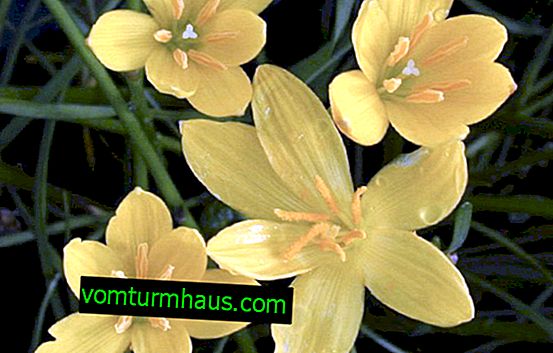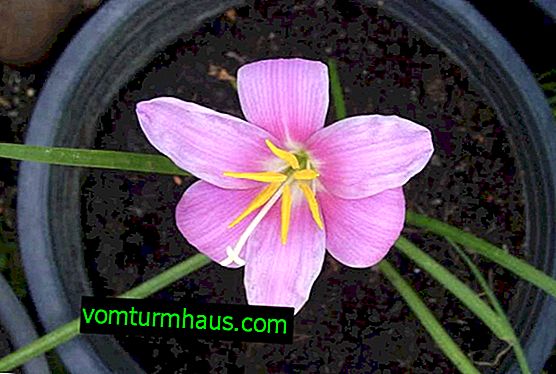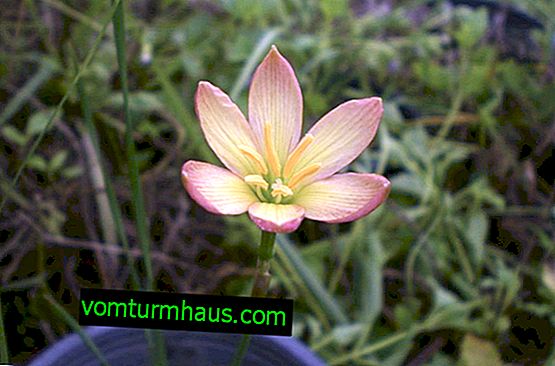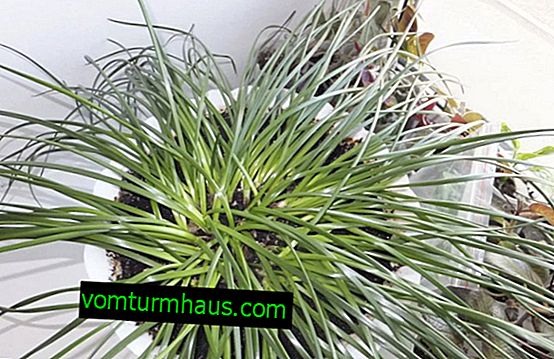How to care for a “upstart” flower at home
Zephyranthes, or, as the flower is also called differently, the “upstart” is very popular among gardeners for its beauty and unpretentiousness. This name the flower received for the incredible speed of flowering and emergence from the ground. Our article invites you to familiarize yourself with the rules of flower care at home, the main difficulties in growing, as well as the signs and superstitions associated with marshmallows.
Botanical description of the plant
Zephyranthes is the bulbous perennial of the Amaryllis family. The native land of the plant is South America, and an upstart grows mainly in the tropics. The etymology of the unusual name is Greek and consists of two parts - “zephyr”, the literal translation of which is “west wind”, and “anthos” - “flower”. The thing is that the appearance of the plant is associated with the onset of the rainy season, the harbinger of which is the west wind. That is why zephyranthes is also called the "rain flower" or "rain lily."
| Flowering time | All seasons except autumn |
| Flower stalk | Tubular, reaches a height of about 40 cm |
| Leaf shape | Linear |
| Leaf color | Dark green |
| Flower shape | Crocus or stellate |
| Flower color | Depends on the species. Most often, red, white and pink colors are found, less often - two-tone species |
| Flower diameter | 8-10 cm |
| Bulb | From 2 to 6 cm in diameter, roundish, strewn with reddish scales. |
In natural habitats, there are about 50 species of plants, but only 10 are grown at home, both in open ground and indoors. Flowering is observed at all seasons, except in the fall, however, due to the huge amount of toxins contained in the plant, in dry weather, most zephyranthes species do not bloom leaves and hide their bulbs underground, thus escaping from drying out and pests.
Only one bulb can produce up to 8 flowers located on thin peduncles, which creates a decorative look of the plant. Zephyranthes himself is low, its leaves are narrow, has star-shaped flowers. Despite the lightning-fast appearance of flowers, a week later they fade and fall. Abundant cultivation of the plant is observed precisely in the summer when kept in open ground.
The main types
Of all fifty flower species, the most popular and suitable for indoor growing conditions are only two - these are white-flowered and large-flowered marshmallows. Each of them has its own timing of flowering, the color of leaves and flowers and the characteristics of care that should be paid attention to during cultivation. Consider the main types of marshmallows in more detail:
- Zephyranthes Atamassky is a herbaceous perennial plant with an egg-shaped bark-necked neck and small few leaves. The flowers are small in diameter, snow-white in color and star-shaped. The flowering period lasts all spring. The most comfortable conditions for keeping the plant are cool and high humidity.

- Zephyranthes white is one of the most popular among flower growers. This species is absolutely not capricious and easily adapts to any, even the most adverse conditions of detention, especially preferring coolness and high humidity. It begins to bloom a little later than its indoor counterpart - from the end of July, ends in November. The plant reaches a height of 40 cm, has a rounded bulb and relatively large leaves that appear along with the flowers. White zephyranthes flowers are very similar to crocus flowers, whitish in color, but are also reddish.

- Golden Zephyranthes is a small perennial plant with an egg-shaped bulb and a linear type of leaves, not exceeding 35 cm in length. The flowers are attractive, funnel-shaped, with a noticeable extension to the middle part, bright yellow. The flowering period is observed almost all winter - from early December to February. This species is unpretentious, therefore, it is allowed to grow at low temperatures. In warm climates, golden marshmallows feel great in open ground.

- Zephyranthes is large-flowered - the species has gained wide popularity due to its long and spectacular flowering: from mid-April to late July. The bulb is small, with a shortened neck, the foliage is linear, narrow, up to 40 cm long. The flowers delight the eye with its catchy red-pink color with a yellowish core. In diameter, they do not exceed 8-10 cm. This variety of zephyranthes can be cultivated in a temperate climate, taking into account regular watering.

- Zephyranthes is multi - colored - it is especially interesting for its unusual color of flowers: the whitish color of the petals smoothly turn into a green-red hue to the outside. Another feature of the species is the late appearance of leaves - after the formation of flowers. Flowering in multi-colored zephyranthes occurs later, as the flowers begin to bloom in late December and bloom throughout January. The bulb is oblong, reaches a length of 40 cm, the leaves are quite large. You can grow this kind of plant in cool rooms.

- Zephyranthes Lindley is a decorative variety of a flower characterized by a long flowering period (throughout the summer). The bulb is large, up to 40 cm. It stands out among other varieties for its unusual foliage, which is much wider and larger than the rest of the plant. Flowers of delicate pink color, large in shape, reaching 8-10 cm in diameter. Despite the early flowering period, it feels most comfortable when kept at home.

House growing conditions
“Upstart” is an unpretentious plant: to obtain flowering it is enough to provide conditions that are as similar as possible to the natural habitat of the flower.
Lighting
Zephyranthes refers to photophilous plants, especially in need of lighting during the growth period, so you can choose both the southern and eastern, western parts of the windowsill as a permanent place to grow it. However, it is better to refrain from the northern side, since in this case there will be a great risk of lack of flowering. You can also put a flower on the balcony, where it will no less actively grow and develop.
In winter, after the plant fades and discards leaves, it will need to be carried away into a shaded or at least dimly lit room. As leaves emerge, sunlight access to zephyranthes resumes.

Ventilation
Ventilate the room, which contains marshmallows, it is necessary regularly, especially in the summer: otherwise the soil may dry out and even mold. If this still happened, the soil is moistened several times a day by spraying with a mist-forming spray. In the cold season, the frequency of this procedure can be reduced to several times a month.
Get acquainted with the features of growing another bulbous flowering plant - hemanthus.
In excessively dry weather, it is advisable to plant zephyranthes in an open area, where constant air supply will contribute to the creation of favorable conditions for development and flowering.
Temperature
It is also very important to observe the temperature regime, in case of instability of which the bulbs can rot. The optimum temperature for the life of the flower is considered to be the interval + 17–24 ° С, and during the dormant period, the temperature must be lowered by 3–4 ° С, removing the “upstart” in a cooler room. The lowest permissible temperature for zephyranthes is + 7 ° С: at a lower rate, the plant will quickly die.

Air humidity
Since the “upstart” is a tropical plant, an exclusively medium or high level of humidity is suitable for its cultivation. Low air humidity can provoke the occurrence of various diseases, so in the summer the flower must be sprayed regularly to maintain the desired level. This procedure is carried out only when using settled water at room temperature once every few days. It is also a good option to place small containers of water around the plant.
Important! During the dormant period, in addition to changing the environment and basic conditions of detention, it is also not recommended to remove the bulbs that are in a dormant state from the pot.
Home Care
The plant is perfectly suited for indoor conditions, delighting its owners with unpretentiousness and suddenly appearing flowers. A big advantage is the zephyranthes’s tolerance for coolness, which greatly facilitates the choice of a permanent place - this can be a staircase, a lobby, or even a porch. Let us consider in more detail how to care for a flower and what should be paid attention to.
Watering
“Upstart” requires not regular, but plentiful watering, as the soil must be in a moistened state. In this case, water stagnation is not recommended, so as not to provoke rotting of the bulbs. It is best to water the plant with settled water immediately after the top layer of the substrate dries slightly.

Top dressing
The flower also responds well to top dressing, which in the active period of its growth and development, it is desirable to spend every week. At the end of flowering, the frequency of this procedure decreases to several times a month. Best upstart is a special mineral fertilizer for indoor plants, which can be purchased at any specialized store. You can also use universal mineral complexes for these purposes, be sure to adhere to the necessary dosage so as not to harm the plant. During the dormant period, feeding the flower is stopped.

Pruning
It is not necessary to trim the “upstart” in any special way, it is enough to remove dried leaves and faded flowers in a period of active budding in a timely manner so as not to overload the plant with extra segments and reduce the risk of infection with diseases. At the end of flowering, the peduncle is also cut off, leaving only 4-5 cm. After it dries, carefully unscrew it.
Careful pruning of dead leaves as necessary will preserve the attractive appearance and decorativeness of the flower.
Transfer
Zephyrantes need to be transplanted every year, waiting for the end of the dormant period. This procedure is carried out in late autumn, but is also allowed at any other time after flowering. The pot must be selected spacious and preferably low so that the bulbs can fit freely, while leaving the necks on the surface of the substrate.
Still, transplanting the “upstart” into a too wide tank should not be done, since a better flower development takes place in a cramped space. The most suitable soil for the plant to grow is loose and nutritious, it must include components such as turf soil, sand, humus and phosphorus fertilizers.
Important! If you have recently purchased a flower in a container that is already spacious and suitable for it, then a transplant is not required.
The transplant process itself is as follows:
- To begin with, the pan of the pot must be filled with good drainage to prevent stagnation of water.
- Carefully remove the plant from the previous container, separating the bulbs with a knife, then clean them with charcoal to prevent rotting of the slices.
- Place the bulbs on the substrate completely, leaving the necks protruding slightly on the surface.
- It is allowed to plant in one capacity the maximum number of zephyranthes bulbs, which will ensure further decorativeness of the plant and non-stop flowering.
- Watering after the procedure is minimized so as not to expose the bulbs to stress and possible rotting.
Video: Transplanting Zephyranthes
Breeding
Indoor zephyranthes species are usually propagated in two ways - with the help of daughter bulbs and seeds. This procedure is carried out exclusively until the period of rest, less often - during it.
Kids
This method is most popular. Onion-children quickly fill the entire space of the pot: up to 12 children can be grown per adult onion, which are easily planted before transplantation into separate containers of 5-7 pieces. The principle of planting children is similar to the principle of transplanting zephyranthes - it is necessary to plant them, deepening into the substrate completely, leaving only the neck on the surface. The soil should also be composed of nutrients and be loose. Seedlings propagated in this way begin to bloom in the same year.
Seeds
In this way, even the most experienced flower growers use it extremely rarely, since the seed transplant process is quite complicated and does not always end in success. The most important condition is to perform the procedure immediately after their maturation, otherwise they will quickly lose their germination. To obtain seeds, it is necessary to conduct artificial pollination, after which they will ripen for several more months.

- The substrate for sowing by seed is used the same as for transplanting, with the exception of adding peat. Before the procedure itself, it needs to be slightly moistened and leveled.
- Selected seeds must be sown a few centimeters apart.
- Then, the container with crops is covered with a plastic film, cleaned in a cool and dark place, and a temperature of at least + 23 ° C is observed.
- The soil must be kept moist.
- Seedlings propagated in this way will bloom only a few years after sowing.
Growing difficulties
Despite the fact that zephyranthes is an undemanding plant and does not have complex features of care, quite often you can encounter various problems when growing. Among the most common are diseases and pests of the flower, but it is also not uncommon for it to dry prematurely or die under the basic conditions of care. Here are the main reasons why the “upstart” does not bloom at home, and how to deal with it:
- Lack of flowering. One of the most common problems experienced by gardeners. If the timing of flowering of your type of zephyranthes has already arrived, and the plant does not show proper activity, this may be due to the fact that during its “rest” the temperature and humidity of the soil were significantly exceeded. Also, there is a high probability of insufficient lighting and too frequent dressing.

- Premature death. The most likely cause is an excess of moisture in the container in which the plant is contained. Only a bulb transplant will help to fix the problem, and before that they must be thoroughly dried, inspected, and only then transplanted into a pre-prepared clean and dry pot. After the procedure, watering of the bulbs stops for several days.
- Diseases and pests. The “upstart” is quite resistant to various diseases and insect infestations, however, prevention of the plant still does not hurt. The most common pests attacking a flower are whiteflies, spider mites and scale insects, which are caused by excessively dry air. The fight against insects occurs only with the help of chemicals - for this, the flower is sprayed with Actellica solution until the pests completely disappear. As for diseases, zephyranthes is most susceptible to fusarium, which manifests itself in the form of yellowing and wilting of leaves, as well as rotting of bulbs. Measures to combat the disease include the destruction of damaged bulbs along with the soil, as well as the treatment of healthy ones in a special solution "Maxim" for half an hour. You can avoid such problems by ensuring proper care of the plant: monitor the necessary level of humidity, lighting and temperature.
Signs and superstitions
Despite all its unpretentiousness and beauty of flowering, there is still an opinion according to which the content at home of the “upstart” is prohibited.

- According to the ancient teachings of Feng Shui, plants with pointed petals, which include marshmallows, negatively affect energy, and therefore are completely unsuitable for indoor use. Only indoor flowers with rounded leaves are acceptable as indoor plants.
- If you nevertheless decided to plant a flower at home, representatives of Feng Shui strongly recommend that you choose a living room or office for its permanent place, but in no case a bedroom.
- Florists are also negative about the upstart, referring to the toxicity of this delicate and fragile plant. Уровень токсичности всех частей зефирантеса очень высокий, а отравление сопровождается рвотой, головной болью и температурой, поэтому после каждого контакта с цветком в обязательном порядке нужно мыть руки.
Несмотря на предостережения флористов, зефирантес можно смело выращивать дома, соблюдая несложные правила техники безопасности и обеспечивая цветку должный уход, и тогда растение обязательно порадует вас даже в самое холодное время года своим изящным сказочным цветением.










